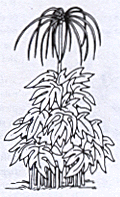Canoe Plants of Ancient Hawai`i Home - Intro - Contents - Bibliography - Links - Credits `Ape - `Awa -`Awapuhi -Hau -Ipu -Kalo -Kamani -Ki -Ko -Kou -Kukui -Mai`a Milo -Niu -Noni -`Ohe -`Ohi`a `Ai -`Olena -Olona -Pia -`Uala -Uhi -`Ulu -Wauke |
Canoe Plants of Ancient Hawai`i Home - Intro - Contents - Bibliography - Links - Credits `Ape - `Awa -`Awapuhi -Hau -Ipu -Kalo -Kamani -Ki -Ko -Kou -Kukui -Mai`a Milo -Niu -Noni -`Ohe -`Ohi`a `Ai -`Olena -Olona -Pia -`Uala -Uhi -`Ulu -Wauke |
 Originating most likely in Southeast Asia, the Polynesian arrowroot plant migrated to Hawai`i Nei in the canoes of early Polynesian settlers. Pia grows throughout tropical Asia and Polynesia, as well as in Australia and Africa.
Originating most likely in Southeast Asia, the Polynesian arrowroot plant migrated to Hawai`i Nei in the canoes of early Polynesian settlers. Pia grows throughout tropical Asia and Polynesia, as well as in Australia and Africa.Pia is best known for its fine nutritious starch, which is extracted from the round tuber, the underground root. Tacca leontopetaloides is Pia's scientific name. Pia is sometimes called tapioca root, but is not to be confused with Manihot esculenta, which is Manioc Cassava - also called tapioca, for its edible starch. Sometimes pia is also confused with Maranta arundinacea, called arrowroot for its arrow-shaped, starchy edible root.
The tuber/hua of pia is white and nearly round. The highly starchy carbohydrate was traditionally grated or pounded and put into a calabash with water, where the starch settled to the bottom.
Each day, the water was poured off and fresh water was added. This was done to release the bitterness of the root. When the bitterness was gone, the starch was spread on flat rocks to dry in the sun.
Later, the sheet of starch was scraped off and ground into a powder using a stone mortar and pestle. Starch that was not immediately needed was stored, often in the shape of small cakes.
Traditionally, prepared pia is mixed with coconut milk or cream and steamed, boiled or baked into the dessert pudding called haupia.
Medicinally, the raw dry starch was added to water and taken several times a day to cure diarrhea. For severe cases, such as dysentery, the pia was mixed with alae, red clay, to provide iron for rehabilitation, being careful to know the right quantities to ingest so as not to cause constipation. This combination was also used to stop internal hemorrhaging in the stomach and colon.
Pia can also be useful in the household, as a laundry starch, to stiffen fabrics.
Polynesian arrowroot grows in moist, open woods at low altitudes, in warm and shady places. It was once widely cultivated, usually alongside lo`i kalo (taro ponds), as well as in village gardens. Nowadays, it is rare and isolated, usually found near streams in the wild or in an occasional garden, where it is often grown as an ornamental plant.
To propagate pia, plant the tuber in a hole, near the end of the rainy season. The best time to harvest the tubers is when the leaves are dry and yellowing. Pia's leaves die in winter, while the underground tubers remain dormant until springtime. In the spring, the slender, finely grooved leafstalks are sent up 1 to 3 feet high, with broad leaves, similar in appearance to papaya leaves - divided, with many lobes. These are 1 to 2 feet wide.
The leaf upper surface has depressed veins, and the under surface is shiny with bold yellow veins. Near the end of the annual above-ground growing season, numerous small green and purple flowers appear at the top of pia's flower stalks. These are accompanied by leafy bracts and by thready green and purplish bracelets that are 4 to 9 inches long.
If growing an old-fashioned Hawai`i garden is a consideration for your family, pia is one of the plants you may wish to include.
| Canoe Plants of Ancient Hawai`i Home Intro - Contents - Bibliography - Links - Credits `Ape -`Awa -`Awapuhi -Hau -Ipu -Kalo -Kamani -Ki -Ko -Kou -Kukui -Mai`a |